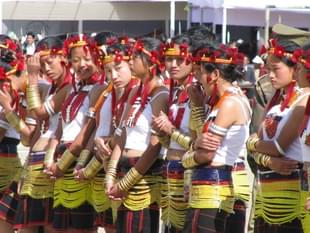Insta
Nagaland To Prepare A ‘Register of Indigenous Inhabitants’ To Protect Native People, Their Traditions And Culture
IANS
Apr 18, 2021, 01:36 PM | Updated 01:36 PM IST
Save & read from anywhere!
Bookmark stories for easy access on any device or the Swarajya app.


The Nagaland government in consultation with all the stakeholders would prepare a Register of Indigenous Inhabitants of Nagaland (RIIN) to protect the indigenous people and their traditional life and culture, officials said on Saturday.
Addressing a consultative meeting with the Civil Society Organisations (CSO) and Tribal Hohos on RIIN late on Friday, Nagaland Chief Minister Neiphiu Rio said that the state has the legitimate right to formulate its own laws and regulations for the interest and protection of its citizens.
He said that the identification of indigenous people among the Nagas of Nagaland is not a problem due to the involvement of the village councils, but identification of indigenous Nagas in other states is a problem, citing the examples of Sikkim, Tripura and Assam where, he said, the indigenous people have now become a minority in their own states.
The Chief Minister said that each tribe shall have its own village, and regional and tribal councils in order to deal with the issues pertaining to violating customary laws and usages. He added that such councils are legal and mandated by the Constitution by an Act.
Opposition leader T.R. Zeliang in his speech highlighted the progress and current position of the Naga political issue after the recent meeting with Union Home Minister Amit Shah.
He said that Shah in his meeting with the Chief Minister, opposition leader, ministers and advisors had said that there cannot be any compromise on the issue of constitution and the flag.
Zeliang had told the Home Minister that "unless the Naga political issue is solved, it is not possible for the Naga society to move ahead for progress and development".
Nagaland Deputy Chief Minister Yanthungo Patton said that the RIIN will aim to strengthen the entire process for issuance of indigenous inhabitant certificates to protect the rights and privileges of the indigenous inhabitants of the state.
To undertake the works of preparing the RIIN, a joint consultative committee headed by the Nagaland Home Commissioner was formed in the consultative meeting.
The meeting also decided to constitute sub-committees at the district level with the Deputy Commissioners as the convenors.
According to officials, the main purpose of RIIN is to identify the citizens who settled in Nagaland prior to December 1, 1963, the day the mountainous region became a full-fledged state. Once the process is completed, persons whose names are included in the RIIN would be issued indigenous inhabitant certificates.
Of Nagaland's two million population, over 86 per cent are tribals from 16 major tribes and several sub-tribes.
All the tribes have their own festivals which they hold sacrosanct and require compulsory participation. Nagas and other tribes celebrate their distinct seasonal festivals with a pageantry of colour and a feast of music.
Each tribe in Nagaland has its own dialect. There are about 60 different spoken dialects which belong to the Tibeto-Burman family of languages and dialects. These dialects have no script of their own.
Tribes speak to each other in Nagamese, an amalgamation of various other dialects.





